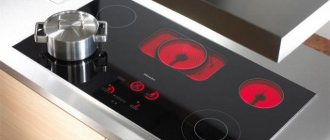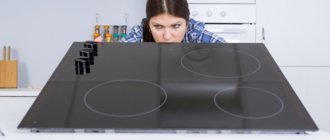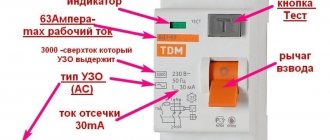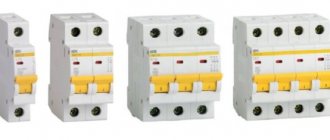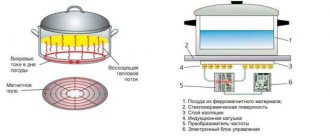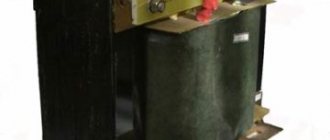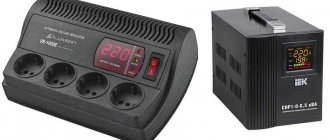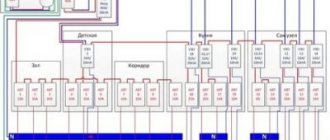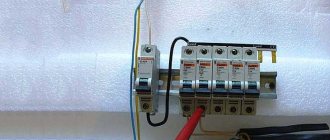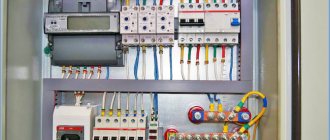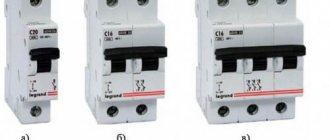Which machine should be installed on the hob and other electrical appliances, what does the choice depend on, and for which consumers should the electric machine be installed? The high power of modern household appliances dictates its own rules; nowadays not a single home can live without circuit breakers. These devices are installed to protect wiring from fire and are selected taking into account the total load, network parameters and other equally important nuances.
Why should the socket for the hob and oven be hung on a separate power line?
It all depends on the characteristics of the technology. Hobs and ovens come in both single-phase and three-phase and can have a power from 2.5 to 10 kW.
Single-phase connection
A “cooker” and/or an oven with a power of up to 3.5 kW is connected to a standard 16 A/220 V outlet. In most cases, the oven has a regular wire and a 16-amp plug (if connected independently), so only an outlet is required. The hob does not have a plug, so you will have to select both a plug and a socket.
For more powerful single-phase models of electric stoves and cabinets from 3.6 to 7 kW
You will need a power socket with characteristics of 32 A/220 V and, if necessary, a special 32A plug.
Three-phase connection
A three-phase hob and/or oven requires a 380 V power supply and a 20 Amp three-phase outlet if the power is not higher than 3.5 kW
or 32 Amps for powerful cooking
from 3.6 to 7 kW
. If the oven and/or hob does not come with a plug, you will also need a 3-phase plug with the appropriate amperage.
Remember.
Plugs and sockets for such equipment must have a grounding contact. That's why they have more pins and holes. Single-phase ones have three (2 feeders and ground), three-phase ones have five (3 feeders, ground and neutral). Connection without grounding is dangerous to life!
Thus, it is impossible to replace special sockets for the hob and oven with models for lighting fixtures and small household appliances.
Expert opinion
Viktor Pavlovich Strebizh, lighting and electrical expert
Any questions ask me, I will help!
However, DO NOT CONFUSE the phase with the grounding, it will constantly knock out plugs, and in the worst case, you can burn the machine or panel. If there is something you don’t understand, write to me!
Choosing a location for an outlet
If you are planning to connect the oven through an outlet installed on a dedicated line, the question immediately arises: where should it be installed. Here's the problem. In this case, the socket and plug are installed as power ones, but their appearance, to put it mildly, is “not very good” and placing them above the work surface is unaesthetic. That’s why they are looking for a hidden installation method. This is where the problem arises: you need to find a place that makes it easy to turn on/off the equipment and that is safe (to exclude the possibility of water, dust, dirt, and mechanical damage). There are several options for solving the problem:
If the kitchen set has a plinth, install it behind the oven, a few centimeters above the floor level. Not the best option. There are many disadvantages. The first is difficult access. To turn the oven off/on from the mains, you have to almost lie down on the floor, sticking your hand all the way to the wall. The second is a high probability of contamination. In the kitchen, even under the furniture, grease and dirt accumulate. They will definitely be on the socket, which worsens contact and reduces electrical safety.
You can install a socket under the oven at the level of the baseboard
Option for installing a socket for connecting a dependent
The best option is in the locker nearby
A few words about choosing a socket and plug. If you install a 16 A machine, it makes sense to install electrical installation devices with the same rating. This guarantees long-term and uninterrupted operation without burning contacts or melting the case.
Where to install sockets under the hob and oven
There are no special requirements here. Usually this is the basement area of the kitchen and the installation height is 10 cm (top edge of the outlet). If the oven is mounted above table level, then it is advisable to also make an outlet nearby.
General rule!
Do not place outlets and auxiliary equipment directly behind equipment. Otherwise, you may end up with a problem—the oven or dishwasher will get stuck and won’t go into place. The same applies to other communications. They need to be installed either next to the equipment or below its level if the equipment is planned to be installed above the floor.
Concealed or outdoor installation
In the case of concrete or brick walls, you can use both options for installing an outlet for an electric stove. From a safety point of view, hidden installation is preferable. But if the repair period has long been completed, external installation using cable channels will also work. When installing, avoid contact of the wire with flammable materials, such as wood, non-fire-resistant plastics.
Remember.
You cannot lay a separate wire for grounding, grounding the outlet to risers or pipes. Do not connect other kitchen appliances to the power circuit of the stove or oven. This is life-threatening.
Selection of circuit breaker rating for current and load power
To select a suitable machine, it is convenient to calculate the current per kilowatt of load power and draw up the corresponding table. Applying formula (2) and a power factor of 0.95 for a voltage of 220 V, we obtain:
Considering that the voltage in our electrical networks often does not reach the required 220 V, it is quite correct to take the value of 5 A per 1 kW of power. Then the table of current versus load will look like this in Table 1:
For example, if you need to find out how many amperes a machine needs for a power of 15 kW with a three-phase current, then we look in the table for the nearest larger value - it is 16.5 kW, which corresponds to a machine with a capacity of 25 amperes.
The question of how many sockets can be connected to one machine can be answered in one phrase: as many as you like. The sockets themselves do not consume electricity, that is, they do not create a load on the network. You just need to make sure that the total power of simultaneously switched on electrical appliances corresponds to the cross-section of the wire and the power of the machine, which will be discussed below.
For a private house or cottage, the input machine is selected depending on the allocated power. Not all owners are able to obtain the desired number of kilowatts, especially in regions with limited power grid capabilities. But in any case, as for city apartments, the principle of dividing consumers into separate groups remains.
Expert opinion
Viktor Pavlovich Strebizh, lighting and electrical expert
Any questions ask me, I will help!
In addition, connecting the cable of an electric stove must be carried out in accordance with the instructions of the PUE and other regulatory and technical documentation relating to the installation and operation of energy-intensive products. If there is something you don’t understand, write to me!
Selection of circuit breaker rating based on wire cross-section
Having determined the rating of the machine based on the power of the “suspended” load, you need to make sure that the electrical wiring can withstand the appropriate current. As a guide, you can use the table below, compiled for a copper wire and a single-phase circuit (Table 3):
As you can see, all three indicators (power, current and wire cross-section) are interconnected, so the rating of the machine can, in principle, be selected according to any of them. At the same time, it is necessary to make sure that all parameters fit together and, if necessary, make appropriate adjustments.
- Installing an overly powerful circuit breaker can lead to the fact that before it operates, electrical equipment that is not protected by its own fuse will fail.
- A machine with a low number of amperes can become a source of nervous stress, cutting off power to the house or individual rooms when the electric kettle, iron or vacuum cleaner is turned on.
77 Comments on “Choosing a machine by power”
Copper cable with a cross section of 10 mm kV for wiring, will it be normal for a 25 ampere circuit breaker?
Boiler 6 kilowatt. what cable is needed and what machine.
1 kilowatt is approximately 4.5 amperes, and 6 kW is 27 A. A 32A automatic machine is close in value. But this is if the load is on one phase. If you have a 3-phase power supply, then there will be 2 kW per phase and therefore 9 A. In the first case, the wire needs 2.5 mm², in the second 0.5 mm² is enough.
Hello! Help me please. Power cable RP 4×2.5. This means I will make three phases and zero, without grounding. Approximately 11 kw. Lathe 380 v. 6.5 kw., with a starting panel on it. How many amps do you need?
I have a three-phase boiler of 9 kilowatts, the machine costs 32, during a power surge the machine did not work, but the boiler burned out, what could be the problem?
What kind of lighting do you prefer?
Built-in Chandelier
Automatic machines vary in purpose, some are triggered by current or voltage load. Yours is most likely normal, in terms of current. Second, 9 kW is 3 kW per phase, and based on the fact that 1 kW is 4.5 A, it was necessary to install a 16 A machine.
Hello, please tell me, I am planning to replace the wiring in a private (village) house, and connect 380V SIP 4*16 from the support line to the control room, in the application for connection I indicated a power of 9 kW, which incoming machine is better to install? I was thinking of running a copper cable from the control room to the in-house switchboard, help me decide on this too
It all depends on the total power consumption. If we take a maximum of 9 kW, and 1 kW - 4.5 A, then we get 40.5 kW. Automatic 40 amp. Cable cross-section for entry into the house according to the PUE: copper - 10 mm sq., aluminum - 16.
The question was about a 380 volt network and three phases, and you answered for a 220 volt network. For three phases with a load of 9 kW, 13.5 amperes per phase, respectively, the automatic is 16 amperes, but not 40.
Hello, Evgeniy! I have a 2.7 kW oven and a 2 kW boiler. Wire cross-section 2.5 square. (4.7÷220=21.36 Ampere. Is it possible to install a 25A machine. Or is it better to do the wiring separately for each device?
Which machine should I put on other consumers?
for an electric oven
The main indicators are the same as those indicated above for hobs, but due to the comparatively lower power of ovens, they can be powered through a three-core cable with a cross-section of 4 mm and a machine with a rating of 16 A or the use of NYM cables. Preference is given to two-pole class “B” circuit breakers, due to the high probability of breakdown - connected through an RCD or differentiated. In this case, the rated current of the RCD should always be one step higher than the rating of the circuit breaker.
for a washing machine
With the average power range of modern washing machines ranging from 2-3.5 W, to protect their power lines, a two-pole circuit breaker with a rated shutdown current of 16 A (25 A for RCDs introduced into the circuit) is sufficient. The optimal leakage current depends on the condition of the wiring; for old but reliable networks it is 30 mA, since installing an RCD or DA with a lower value (namely, 10 mA recommended for wet rooms) results in many false alarms. When protecting new circuits, 10 mA diphatmoates are installed. Additional sockets are not connected to the group.
for air conditioning
When calculating the circuit breaker rating and selecting the wire cross-section for these devices, it is important to use the correct power value (consumption, not cooling) and take into account the maximum inrush current. As a rule, to power standard household air conditioners with a power consumption of up to 2 kW, a wire with a cross-section of 1.5 m2 and a rating of 16 A is sufficient; for “eighteenth” and higher models this value is 2.5 mm2 and 25 A, respectively. There is no need for differential protection of air conditioners; due to high starting loads, the line is protected by an automatic device with a class of at least “C”.
on the refrigerator
Due to the relatively low power consumption and low risk of leakage currents, modern refrigerators are powered through power lines with a conventional 10 or 16 A circuit breaker. Some owners add additional sockets to the line, which is generally not recommended, but is acceptable when monitoring the total power of connected devices. The outlet for the refrigerator must be grounded.
for an electric boiler
When connecting powerful water heating devices (heating boilers, instantaneous heaters, boilers of various types), the rating of the machine and the wire cross-section are selected according to the passport or from tables, with obligatory consideration of the phase and network condition. In modern single-phase networks, line and consumer protection is provided by a two-pole difautomatic circuit breaker (30 mA) or an RCD with a rating one step higher than a conventional circuit breaker.
for the heating system pump
Ideally, these devices are powered from an uninterruptible power supply and a voltage stabilizer; if this is not possible, any automatic device suitable for the current and type of wires, usually with a small rating, is introduced into the circuit.
for lighting
To power standard household lighting or alarm systems, wires with a cross-section of 1.5 mm2 and a machine rating of 10 A with a current limit of 16 A are sufficient. The recommended maximum load power is 4.1 kW; there is no need to connect via an RCD or DA.
How to connect an electric stove to a 220 V network
Connecting the cable to the electric stove
First, the cable selected for connection must be connected to the electric stove. On the rear panel, usually at the bottom left there is a terminal block to which the conductors are routed.
The terminal block to which the electrical cord must be connected
Nearby are connection diagrams for different networks.
Schematic illustration of connections for different networks
With a 220 V network, the diagram is on the far right. On the plate, contacts 1,2,3 should be connected by one jumper - this will be the phase (red or brown conductors), the second - contacts 4 and 5 - this is neutral or zero (blue or blue), the sixth contact is ground (green or yellow -green). Electrical plates usually come from the store with jumpers already installed, but it doesn’t hurt to check.
It is more correct and reliable to crimp the conductors with contact plates, and then connect them. This connection is more reliable, but often the conductors are simply twisted around the clamping screw and then tightened. In any case, it is better to follow the color coding - this way there is less chance of making a mistake.
It is better to terminate the conductors with contact plates
Plug installation
Next, a plug is connected to the cable. The power plug is collapsible. Unscrew the two mounting screws and remove the cover with contacts. The fixing bar holding the cable is also removed. The protective insulation is removed from the edge of the flexible cable (about 5-6 cm), the conductors are straightened, their ends are also stripped of insulation by about 1.5-2 cm. The cut end of the cable is inserted into the plug body.
The clamping screws on the contacts are loosened, the conductors, if they are multi-core, are twisted into a bundle. These flagella are twisted around the contacts and tightened with clamping screws.
The distribution of conductors matters and they must be connected carefully. The top contact of the plug is usually labeled - the “ground” wire (green) is connected here. When connecting a socket, you need to apply ground to a similar connector.
The other two contacts are “phase” and “zero”. Where to apply which one is not important, but when connecting the socket, the “phase” must fall on the “phase”, the “zero” must fall on the “zero”. Otherwise there will be a short circuit. So before turning it on, be sure to double-check that the wires (phase and neutral) are screwed in correctly.
Expert opinion
Viktor Pavlovich Strebizh, lighting and electrical expert
Any questions ask me, I will help!
An instruction diagram for connecting the surface terminals to a one-, two- and three-phase network is glued to the bottom cover of the product. If there is something you don’t understand, write to me!
Connection to a three-phase 380 V network
In this case, an automatic machine and an RCD for a three-phase network are purchased; the wires must be five-core (the cross-section is determined using the same table, only the value must be looked at in the 380 V column). The plug and socket must also have five contacts.
The connection process itself will not differ in anything, only in the number of wires. The difference will be when connecting the wire to the output terminals of the electric stove. Only one jumper will be installed - on pins 5 and 6. All others are connected with separate conductors.
It is also necessary to monitor the position of “ground” and “neutral” (or they also say “zero”). The color matching of the conductors on the phases is not critical, but it is more convenient if they also match.
Today, many people are abandoning conventional gas stoves in favor of electric ones. Some because it is impossible to use gas, for example, in a private home or cottage, and some simply because it is stylish and looks better in the interior. Well, to each his own.
Every owner can cope with connecting an electric stove. It's not difficult at all and won't take much time.
When connecting, if you need to “pick” the socket, do not forget to turn off the electricity in the panel.
If you also had an electric stove before and you just want to replace it with a new one, then in this case everything is much simpler. Just take the plug from the old stove, attach it to the new one, and “voila!”, you're done!
Note! If the plug is very old, there are cracks, chips, or burnt contacts, be sure to replace it with a new one, out of harm’s way. Most often, a regular, single-phase plug will do. Also, if a high-power electric stove is connected, then it may be necessary to replace the socket with a special, more “powerful” socket.
To connect an electric stove or oven with a power of up to 3 kW, ordinary wiring and the most ordinary socket will be enough. The main thing is to ensure that several powerful electrical appliances are not simultaneously connected to one “core” of wires, otherwise the protection will be triggered when they operate simultaneously.
Connection features
Electric ovens and hobs are energy-intensive household appliances, so they are approached with the utmost responsibility when connecting these appliances.
Regardless of whether the oven is installed independently or in conjunction with a hob, the connection is made only if the following conditions are met:
If these conditions are not met, a new route is laid from the panel to the installation site of the equipment with a circuit breaker of a suitable rating.
A little theory
It is known from the physics course that there is a relationship between electrical power, current strength and voltage in the electrical network. In a simplified form, this relationship is expressed by the following formula for a single-phase network:
In this case, we will be interested in the current strength, since the circuit breaker and electrical wiring characteristics are often selected based on this parameter. For convenience, we transform the above formula into the expression:
As an example, let’s calculate the current strength for the load that the energy-intensive consumers mentioned above provide to the power grid. Their total power will be about 6 kW, and at a voltage of 220 V we get the current in the circuit:
For a three-phase connection diagram, formula (2) will take the following form:
This change is caused by the fact that with an equal load and uniform distribution of power across phases, the current in a three-phase network will be three times less. Thus, with the same total power of 6 kW, but at a voltage of 380 V, the current in the circuit will be equal to:
Having received this indicator, you can begin to select a circuit breaker that provides network overload protection.
Expert opinion
Viktor Pavlovich Strebizh, lighting and electrical expert
Any questions ask me, I will help!
The first parameter is indicated in the passport data, the second depends on the number of cable cores supplied to the plate (three-core or five-core), and this already depends on the single- or three-phase power supply. If there is something you don’t understand, write to me!
Selection of circuit breaker rating for current and load power
To select a suitable machine, it is convenient to calculate the current per kilowatt of load power and draw up the corresponding table. Applying formula (2) and a power factor of 0.95 for a voltage of 220 V, we obtain:
Considering that the voltage in our electrical networks often does not reach the required 220 V, it is quite correct to take the value of 5 A per 1 kW of power. Then the table of current versus load will look like this in Table 1:
For example, if you need to find out how many amperes a machine needs for a power of 15 kW with a three-phase current, then we look in the table for the nearest larger value - it is 16.5 kW, which corresponds to a machine with a capacity of 25 amperes.
The question of how many sockets can be connected to one machine can be answered in one phrase: as many as you like. The sockets themselves do not consume electricity, that is, they do not create a load on the network. You just need to make sure that the total power of simultaneously switched on electrical appliances corresponds to the cross-section of the wire and the power of the machine, which will be discussed below.
For a private house or cottage, the input machine is selected depending on the allocated power. Not all owners are able to obtain the desired number of kilowatts, especially in regions with limited power grid capabilities. But in any case, as for city apartments, the principle of dividing consumers into separate groups remains.
Carrying out installation work
The main thing when performing electrical installation work is compliance with safety rules. Always operate with the power switched off.
Connecting the plug and socket
To connect the plug, strip the wire from the oven or stove; if the wire is stranded, then crimp it with NShV lugs and pass it through the plug body. Mount the phase and neutral on the outermost contacts of the plug. Yellow-green grounding conductor - on the middle contact. To prevent the wire from dangling inside the plug, clamp it with a clamp and tighten the plug body.
The socket is connected in the following way: the socket is mounted in the required place, the socket body is removed and the power line is connected to it. Mount the phase and neutral on the outermost contacts of the socket. Yellow-green grounding conductor - on the middle contact. Next, screw the socket housing.
Cable connection diagrams for the oven and hob
Single-phase 220V circuit (most common in apartments)
Phase L is simultaneously connected to terminals L1-3 of the hob. To do this, two removable copper jumpers are installed between them at the manufacturer. If for some reason you don’t have jumpers, you can make them yourself from an electrical cable whose cross-section is no less than that of the supply cable. Zero N is connected to terminals N1-2. Protective conductor PE – to the PE terminal.
Three-phase 380V circuit (common in private homes and businesses)
Phases A, B, C – are connected to terminals L1-3 of the hob. In this case, it is necessary to remove the jumpers installed at the factory between terminals L1-3. Zero N is connected to terminals N1-2. Protective conductor PE – to the PE terminal.
The oven connection diagram is always single-phase:
What sockets are needed for the hob and oven |
This change is caused by the fact that with an equal load and uniform distribution of power across phases, the current in a three-phase network will be three times less. Thus, with the same total power of 6 kW, but at a voltage of 380 V, the current in the circuit will be equal to:
Expert opinion
Viktor Pavlovich Strebizh, lighting and electrical expert
Any questions ask me, I will help!
For example, if you need to find out how many amperes a machine needs for a power of 15 kW with a three-phase current, then we look in the table for the nearest larger value; it is 16.5 kW, which corresponds to a machine with a capacity of 25 amperes. If there is something you don’t understand, write to me!
Installing the Terminal Block
Connecting household appliances via a terminal block is considered more reliable. Contact here is ensured by clamping screws, which is more reliable than when connected through a plug and socket. The disadvantage of this connection is the relative difficulty of breaking the circuit. You will have to remove the cover, unscrew the bolts that hold the wires, and pull them out. Therefore, it is used only if there is a circuit breaker on the line. Moreover, it is desirable that it be bipolar and break both phase and neutral at once.
In terminal blocks of the “old” type - carbolite - the contacts are open; it is better to install such a block in a small box. In order not to overpay for the box, you can use a standard junction box. A three-pin block fits perfectly into a square one. If you need to connect the oven to a three-phase network, you will need to install an oblong model under the five-pin socket.
Option for installing a terminal block for connecting an oven
The box can be fixed to the wall surface. This option is suitable if the wiring is pulled after the repair is completed. If the cable is laid in a groove, it makes sense to recess the box into the wall.
When connecting, you will need to insert the wires stripped of insulation under the metal plates and tighten the contact with clamping bolts (screwdriver). In this case, you need to make a decent effort so that the contact is good. Please note that the wires cannot be mixed up when connecting. The phase wire from the oven should be opposite the phase wire that came from the panel, the neutral (zero) should be strictly opposite to zero, the ground should be opposite the ground wire. It is important. Be careful.
Selecting a machine based on load power and wiring, introductory machine
- I use a 1.5 sq. mm cable when installing alarms and lighting; it corresponds to a 10A machine;
- a 2.5 sq. mm cable is often used for individual sockets and socket groups, where the total power of consumers will not exceed 3.5 kW. It corresponds to the current ratings of 16A automatic machines;
- a 4 sq. mm cable is used in everyday life to connect ovens, washing machines and dishwashers, heaters and water heaters; they buy a 25A automatic machine for it;
- a 6 sq. mm cable is needed to connect serious powerful consumers: electric stoves, electric heating boilers. Machine rating 32A;
- a cable of 10 sq. mm is usually the maximum cross-section used in everyday life, intended for supplying power to apartments and private houses to electrical panels. Automatic 40A.
How many amps does an oven need?
The oven socket must be equipped with a ceramic insulator. The outlet current is at least 16 amperes.
Interesting materials:
How to use protein correctly? How to take bcaa capsules correctly? How to take protein correctly? How to take maximum glucosamine? How to take glucosamine correctly? How to take glutamine powder correctly? How to take apple fiber correctly? How to take coenzyme q10 correctly? How to take letrozole correctly? How to take Lipo 6 Black Hers correctly?
Selecting a power cable
According to the PUE, clause 7.1.34, the cable must be copper. Three-wire if you have single-phase power at home (picture above). Five-wire for three-phase.
Cable cross-section is the cross-sectional area of 1 copper core in mm².
Cable selection is described in detail here. Let's add a pivot table:
| 1,5 | 19 | 4,2 | 16 | Lighting, alarm |
| 2,5 | 27 | 6,0 | 25 | Socket group, warm floor |
| 4 | 38 | 8,4 | 32 | Air conditioning, water heater |
| 6 | 46 | 10,1 | 40 | Electric stove, oven |
| Surface power, kW | Up to 3.5 | 3,5–5,5 | 5,5–7,2 | 7,2–8,8 |
| Single-phase network, mm2, 3 wires. cable | 3*2,5 | 3*4 | 3*6 | 3*10 |
| Rated current of the difavtomat, A (mA) | 16 (30) | 25 (30) | 32 (30) | 40 (30) |
| Two-phase network, mm2, 4 cores. cable | 4*2,5 | 4*4 | 4*6 | 4*10 |
| Rated current of the difavtomat, A (mA) | 16 (30) | 25 (30) | 32 (30) | 40 (30) |
| Three-phase network, mm2, 5 wires. cable | 5*2,5 | 5*2,5 | 5*2,5 | 5*2,5 |
| Rated current of the difavtomat, A (mA) | 16 (30) | 25 (30) | 25 (30) | 25 (30) |
For a two-phase network, the parameters of the cable cores and the difavtomat coincide with the parameters of a single-phase network. Although, logically, the load on the core in a two-phase network is two times less than that in a single-phase network. But, let's look at the connection diagram of a three-phase surface to a two-phase network, taken from here
| Surface power, kW | Up to 3.5 | 3,5–5,5 | 5,5–7,2 | 7,2–8,8 |
| Single-phase network, mm2, 3 wires. cable | 3*2,5 | 3*4 | 3*6 | 3*10 |
| Rated current of the difavtomat, A (mA) | 16 (30) | 25 (30) | 32 (30) | 40 (30) |
| Two-phase network, mm2, 4 cores. cable | 4*2,5 | 4*4 | 4*6 | 4*10 |
| Rated current of the difavtomat, A (mA) | 16 (30) | 25 (30) | 32 (30) | 40 (30) |
| Three-phase network, mm2, 5 wires. cable | 5*2,5 | 5*2,5 | 5*2,5 | 5*2,5 |
| Rated current of the difavtomat, A (mA) | 16 (30) | 25 (30) | 25 (30) | 25 (30) |
Expert opinion
Viktor Pavlovich Strebizh, lighting and electrical expert
Any questions ask me, I will help!
In the meantime, use it with great care and with safety measures that will allow you to avoid various damages. If there is something you don’t understand, write to me!
What kind of wiring is needed for an electric stove?
The most common option is VVG 3x6 3-core wire, copper with a cross-section of 6 mm², it will last up to 30 years! Cables VVGng (non-flammable), NYM will be more expensive, but the stove
Connect once, you can spend a little money. If the device is of low power up to 6 kW, you can use a similar wire with a cross-section of at least 4 mm².
Interesting materials:
Which soldering iron is better to choose for soldering microcircuits? Which parquet is better to choose? Which tablet to choose for Yandex Taxi? Which tablet to choose for car navigation? What density should I choose foam block for building a house? Which used car should you choose? Which used crossover should you choose? Which power bank to choose for a smartphone? Which Powerbank to choose 2022? Which Powerbank to choose 2022?
